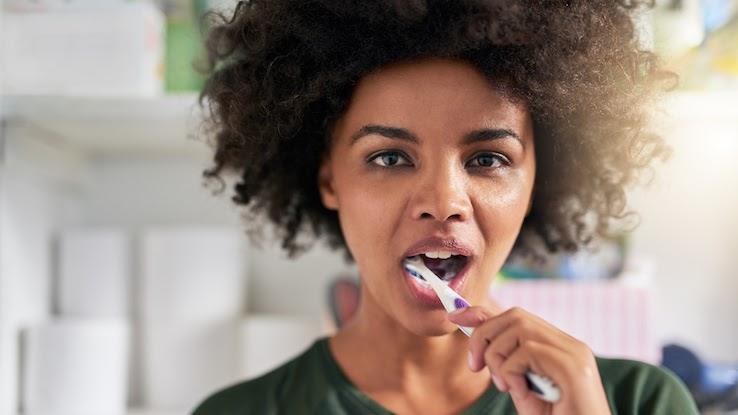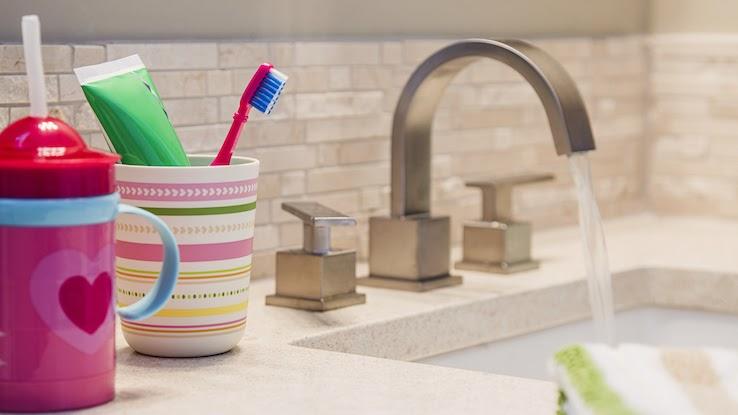Could I Only Do The Lower Teeth Deep Cleaning

If you lot can't nourish to your dental hygiene after every repast, dentists recommend brushing your teeth at to the lowest degree twice a twenty-four hours. Simply while y'all may be aware of your oral cavity's cleanliness, you might not be paying enough attention to your toothbrush's hygiene.
Even if y'all dutifully run your toothbrush under hot water earlier brushing, germs might even so observe a way to crusade problems. Much in the aforementioned way y'all clean your bed sheets, you should be cleaning your toothbrush head on a regular footing, besides. Hither, we've rounded up a few simple and effective tips for deep cleaning your toothbrush.

Looking to deep make clean your toothbrush? Hydrogen peroxide is a great disinfectant. In fact, researchers found that soaking the caput of a toothbrush in 3% hydrogen peroxide was found to kill 100% of germs. Antiseptic mouthwash, which generally contains hydrogen peroxide, is also a nifty disinfectant. Not to mention, mutual mouthwash ingredients — alcohol, menthol, eucalyptol — tin can also effectively kill leaner.
So, what's the procedure like? Kickoff, rinse the bristles of your toothbrush in water to go rid of any food particles. Next, cascade enough mouthwash or hydrogen peroxide into a small cup and then that the solution volition encompass the toothbrush, and leave your handy hygiene tool to soak for well-nigh fifteen minutes — if yous leave it longer, the bristles might cease upwards damaged, and that's also not great for your oral wellness.
Disinfect Your Toothbrush with Vinegar and Baking Soda

Of class, you tin also deep clean your toothbrush with some commonplace kitchen products. Baking soda, for example, is a natural disinfectant. Just mix two teaspoons of blistering soda into a loving cup of water, and, after the baking soda has dissolved, soak your toothbrush in the solution for 15 minutes. Subsequently, rinse your toothbrush in water and let it air dry.
But blistering soda isn't the only helpful kitchen product at your disposal; soaking your toothbrush in vinegar overnight once a calendar week is also a great way to kill germs. To avert staining your brush's bristles, use white vinegar. Can't decide betwixt vinegar and baking soda? Add two tablespoons of vinegar and a scoop of baking soda to a 1/2 cup of water and let your toothbrush soak for thirty minutes.
Kill Pesky Germs on Your Toothbrush with a UV Sanitizing Light

Ultraviolet (UV) sanitizing lights might bring you back to high school chemistry class, but they're also an increasingly popular manner to clean everyday items, like phones and, well, toothbrushes. Dissimilar some of these other cleaning methods, UV sanitizing lights can be a pricier investment depending upon the size y'all want. For a toothbrush, you can go pretty small, so y'all likely won't spend too much more than than $x. No matter the size, make certain your brush head's bristles are facing the bulb and they'll get a squeamish cleaning.
Although UV light has been establish to exist less effective means of killing germs on your toothbrush than hydrogen peroxide or mouthwash, it tin can however go the job washed. And this method is certainly better than simply running your toothbrush under some water. Equally noted by the American Dental Association (ADA), you should only buy a UV sanitizing light that has been approved by the U.S. Nutrient & Drug Administration (FDA) if you're planning to utilize information technology as a toothbrush cleaner.
Turn to Denture Cleaners for an Effective Toothbrush Deep Make clean

Perhaps unsurprisingly, denture cleaning tablets are another corking way to beautify your toothbrush. As the name implies, they're most usually used to keep dentures squeaky clean, but these tablets and their foaming action — a mix of sodium bicarbonate and citric acid — can also loosen nutrient particles that take been trapped in the brush.
Typically, yous'll just add these germ-killing tablets to a cup of warm water. In one case the tablet dissolves, soak your toothbrush for up to x minutes for the best results. After your toothbrush gets a nice soak, rinse it off under some water and let it air dry.
How to Avert Toothbrush Germs in the First Place

Preventative care can also exercise wonders when it comes to maintaining a clean toothbrush. After using your toothbrush, rinse it nether warm water to remove any excess toothbrush or food debris; subsequently the rinse, shop your toothbrush in an upright position and then that it tin can air dry properly. As you might expect, leaving your toothbrush in a closed container for a long period of time will cultivate more than leaner. If you use toothbrush covers, be sure to make clean them regularly with soap and water — and, on that note, do the aforementioned with your toothbrush holder.
Other Toothbrush Care Tips:
- Although it may seem obvious, avoid sharing your toothbrush with other people — unless you like spreading bacteria.
- Avoid storing multiple toothbrushes in the same holder or drawer; bristle-to-bristle contact is another surefire way to spread germs.
- Get a new toothbrush every 3 months.
- If the toothbrush's bristles are worn or bent, replace your toothbrush before the 3 months are up.
- If you've been ill, supersede your toothbrush once you feel amend to avoid any lingering bacteria that could atomic number 82 to a reinfection.
- Do NOT put your toothbrush in the dishwasher, microwave or a pot of boiling h2o. These methods can exist ineffective, but, moreover, they can deal serious damage to your brush, especially the bristles.
- Continue your toilet lid airtight to avoid spreading airborne bacteria. Flush with the chapeau shut and store your toothbrush as far away from the toilet as possible.
Resources Links:
- "Efficacy of Diverse Disinfectants on Microbially Contaminated Toothbrushes Due to Brushing" via Gimmicky Clinical Dentistry, U.S. National Library of Medicine | NCBI
- "A Clean Toothbrush May Help Protect You From The Flu" via Maryland Children'due south Oral Health Plant
- "5 Tips to Clean Your Toothbrush and Keep It Germ-free" via Insider
- "Evaluating Sanitization of Toothbrushes Using Ultraviolet Rays…" via U.S. National Library of Medicine | NCBI
- "Toothbrushes" via American Dental Association (ADA)
- "How to Disinfect a Toothbrush: Tips on How to Keep Them Clean" via Eric Kitts DDS, Soundview Family unit Dental
- "4 Tips for a Make clean Toothbrush" via Cleveland Clinic
- "Project Clean Toothbrush: Important Tips to Aid Foreclose the Spread of Germs" via The Children's Oral Health Plant
Source: https://www.symptomfind.com/healthy-living/how-to-clean-toothbrush-head-tips?utm_content=params%3Ao%3D740013%26ad%3DdirN%26qo%3DserpIndex
Posted by: varnerfroddly.blogspot.com


0 Response to "Could I Only Do The Lower Teeth Deep Cleaning"
Post a Comment